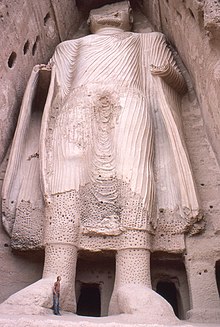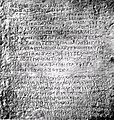Buddhism in Afghanistan


Buddhism, a religion founded by Gautama Buddha, first arrived in modern-day Afghanistan through the conquests of Ashoka (r. 268–232 BCE), the third emperor of the Maurya Empire. Among the earliest notable sites of Buddhist influence in the country is a bilingual mountainside inscription in Greek and Aramaic that dates back to 260 BCE and was found on the rocky outcrop of Chil Zena near Kandahar.[1]
Many prominent Buddhist monks were based in Afghanistan during this period: Menander I (r. 165–130 BCE), a Greco-Bactrian king, was a renowned patron of Buddhism and is immortalized in the Milinda Panha, a Pali-language Buddhist text; Mahadharmaraksita, a 2nd-century BCE Indo-Greek monk, is said to have led 30,000 Buddhist monks from "Alasandra, the city of the Yonas" (a colony of Alexander the Great, located approximately 150 kilometres or 93 miles to the north of modern-day Kabul) to Sri Lanka for the dedication of the Mahathupa in Anuradhapura, according to the Mahavamsa (Chap. XXIX);[2] Lokaksema, a 2nd-century Kushan monk, travelled to the Chinese capital city of Luoyang during the reign of the Han dynasty, and was the first translator of Mahayana Buddhist scriptures into the Chinese language.[3]
The Nava Vihara monasteries, located near the ancient city of Balkh in northern Afghanistan, functioned as the centre of Buddhist activity in Central Asia for centuries.
The religion began to decline in Afghanistan after its conquest by Arab Muslims following the rise of Islam in the 7th century CE; it saw further decline in the region during the Muslim Ghaznavid era of the 10th–12th centuries.[4] Buddhism was eliminated in Afghanistan by the 13th century during the Mongol conquests,[5][6] with no further mention of a Buddhist presence in the area past the 14th century.[4]
History
The territory within the modern borders of Afghanistan has seen many cultural and religious shifts over the centuries. The geographical position of the area between the Middle East, South Asian, and Central Asian cultures, and the proximity to the famous Silk Road (connecting East Asian and Mediterranean civilizations, and others in between), have been major drivers of local historical and cultural developments. One major influence was the conquest of the area by Alexander the Great, which incorporated the area for a time into the Hellenistic World, and resulted in a strong Hellenistic influence on Buddhist religious art in that region. In 305 BC, the Seleucid Empire made an alliance with the Indian Maurya Empire. The Mauryans brought Buddhism from India subcontinent and controlled the area south of the Hindu Kush until about 185 BC when they were overthrown.
Alexander took these away from the Aryans and established settlements of his own, but Seleucus Nicator gave them to Sandrocottus (Chandragupta), upon terms of intermarriage and of receiving in exchange 500 elephants.[7]
— Strabo, 64 BC – 24 AD

At the time of these developments, most of the area belonged to the kingdoms of Bactria and Sogdiana, including the Scythians, followed Buddhism until the arrival of Islam.
After the Mauryan Empire, Buddhism also flourished under the Kushan Empire, when a tribe called the Yuezhi conquered Bactria and entered the region of modern day Afghanistan.[8] Many monuments testify to the Buddhist culture in present-day Afghanistan. Additional historical detail can be researched under Pre Islamic Hindu and Buddhist heritage of Afghanistan and Hinduism in Afghanistan.
Soon after the Sassanian Persian dynasty fell to the Muslims (in 651 AD), the Nava Vihara monastery in Balkh came under Muslim rule (in 663 AD), but the monastery continued to function for at least another century. In 715 AD, after an insurrection in Balkh was crushed by the Abbasid Caliphate, many Persian Buddhist monks fled east along the Silk Road to the Buddhist Kingdom of Khotan, which spoke a related Eastern Iranian language, and onward into Tang China. Nava Vihara's hereditary administrators, the Persian Barmakids, converted from Buddhism to Islam after the monastery's conquest and became powerful viziers under the Abbasid caliphs of Baghdad. The last of the family's line of viziers, Ja'far ibn Yahya, is a protagonist in many tales from the Arabian Nights. In folktales and popular culture, Ja'far has been associated with a knowledge of mysticism, sorcery, and traditions lying outside the realm of Islam.
The Buddhist religion survived the Islamic conquest of Afghanistan by the Umayyads and successive rule by the Abbasid Caliphate. Buddhism in Afghanistan was effectively destroyed in the 13th century by Mongol armies during the Mongol conquests.[6][5]
Archaeological finds

Bamiyan monastery library
One of the early Buddhist schools, the Mahāsāṃghika-Lokottaravāda, were known to be prominent in the area of Bamiyan. The Chinese Buddhist monk Xuanzang visited a Lokottaravāda monastery in the 7th century CE, at Bamiyan, Afghanistan, and this monastery site has since been rediscovered by archaeologists.[9] Birchbark and palm leaf manuscripts of texts in this monastery's collection, including Mahāyāna sūtras, have been discovered at the site, and these are now located in the Schøyen Collection. Some manuscripts are in the Gāndhārī language and Kharoṣṭhī script, while others are in Sanskrit and written in forms of the Gupta script. Manuscripts and fragments that have survived from this monastery's collection include the following source texts:[9]
- Pratimokṣa Vibhaṅga of the Mahāsāṃghika-Lokottaravāda (MS 2382/269)
- Mahāparinirvāṇa Sūtra, a sūtra from the Āgamas (MS 2179/44)
- Caṃgī Sūtra, a sūtra from the Āgamas (MS 2376)
- Vajracchedikā Prajñāpāramitā Sūtra, a Mahāyāna sūtra (MS 2385)
- Bhaiṣajyaguru Sūtra, a Mahāyāna sūtra (MS 2385)
- Śrīmālādevī Siṃhanāda Sūtra, a Mahāyāna sūtra (MS 2378)
- Pravāraṇa Sūtra, a Mahāyāna sūtra (MS 2378)
- Sarvadharmapravṛttinirdeśa Sūtra, a Mahāyāna sūtra (MS 2378)
- Ajātaśatrukaukṛtyavinodana Sūtra, a Mahāyāna sūtra (MS 2378)
- Śāriputrābhidharma Śāstra (MS 2375/08)
Buddhist relics
In August 2010, it was reported that approximately 42 Buddhist relics have been discovered in Mes Aynak of the Logar Province in Afghanistan, which is south of Kabul. Some of these items date back to the 2nd century according to Archaeologists. Some Buddhist sites were found in Ghazni.[10] The items in Logar include two Buddhist temples (Stupas), Buddha statues, frescos, silver and gold coins and precious beads.[11][12][13]
Buddhist sites
- Tepe Narenj
- Bamiyan
- Haḍḍa
- Tapa Sardar
- Tapa Shotor
- Takht-i-Rustam
- Mes aynak
- Chakhil-i-Ghoundi Stupa
- Tepe Kafiriyat
Buddhist historical figures from Afghanistan
- Prajñā, 9th-century Buddhist monk from what is now Kabul
- Barmakid family, hereditary monks of the Nava Vihara monastery close to Balkh prior to their conversion to Islam
- Buddhabhadra, 5th century monk and translator born in Nagarahāra (modern-day Jalalabad)
Gallery
-
Cave system, stupa and monastery at Samangan, Takht-i-rustam
-
The Bodhisattva and Chandeka, Hadda, 5th century CE
-
Wardak Vase in British Museum
-
Bamiyan Grotto paintings
-
Afghanistan, stupa TK23, hadda site, tapa-kalan monastery, 4th-5th cent
-
Afghanistan, capital of stupas, from the site of hadda, chakhil-i-ghoundi monastery, II-III century
-
Afghanistan, stairway of stupas, from the site of hadda, chakhil-i-ghoundi monastery, II-III cent
-
Court with stupa, after excavation, Ali Masjid
-
Shewaki stupa
-
General view of Stupa No. 6, with Buddha images
-
Reconstitution of the Buddhist monastery of Ahin Posh Tepe, Afghanistan
-
Grey schist figure of Buddha, Auckland Museum
-
Afghanistan Buddhist art
-
Begram Decorative plaque from a chair or throne, ivory, room 13, c.100 BCE
See also
- Buddhism in Central Asia
- Great Tang Records on the Western Regions
- Jñānagupta
- Kandahar Greek Edicts of Ashoka
- Kandahar Bilingual Rock Inscription
- Pre-Islamic Hindu and Buddhist heritage of Afghanistan
- Silk Road transmission of Buddhism
- Decline of Buddhism in the Indian subcontinent
- Hinduism in Afghanistan
- Trapusa and Bahalika
References
- ^ Runion, Meredith L. (2007). The history of Afghanistan. Westport: Greenwood Press. ISBN 978-0-313-33798-7.
- ^ Full text of the Mahavamsa Click chapter XXIX Archived 5 September 2006 at the Wayback Machine
- ^ Foltz, Religions of the Silk Road, p. 46
- ^ a b Berzin, Alexander (December 2006). "History of Buddhism in Afghanistan". Archived from the original on 1 November 2016. Retrieved 5 June 2016.
- ^ a b Steven Otfinoski (2004). Afghanistan (illustrated ed.). Infobase Publishing. p. 6. ISBN 0-8160-5056-2. Archived from the original on 14 January 2023. Retrieved 18 September 2011.
- ^ a b Amy Romano (2003). A Historical Atlas of Afghanistan (illustrated ed.). The Rosen Publishing Group. p. 25. ISBN 0-8239-3863-8. Retrieved 18 September 2011.
- ^ Nancy Hatch Dupree / Aḥmad ʻAlī Kuhzād (1972). "An Historical Guide to Kabul – The Name". American International School of Kabul. Archived from the original on 30 August 2010. Retrieved 18 September 2010.
- ^ Runion, Meredith L. (2007). The history of Afghanistan. Westport: Greenwood Press. p. 46. ISBN 978-0-313-33798-7.
The Yuezhi people conquered Bactria in the second century BCE. and divided the country into five chiefdoms, one of which would become the Kushan Empire. Recognizing the importance of unification, these five tribes combined under the one dominate Kushan tribe, and the primary rulers descended from the Yuezhi.
- ^ a b "Schøyen Collection: Buddhism". Archived from the original on 10 June 2012. Retrieved 23 June 2012.
- ^ Embassy of the United States, Kabul. Ghazni 10.26.2011 Archived 25 June 2016 at the Wayback Machine
- ^ Embassy of the United States, Kabul. Mes Aynak 10.29.2011 Archived 16 November 2015 at the Wayback Machine
- ^ "42 Buddhist relics discovered in Logar". Maqsood Azizi. Pajhwok Afghan News. 18 August 2010. Archived from the original on 17 March 2010. Retrieved 23 August 2010.
- ^ "Afghan archaeologists find Buddhist site as war rages". Sayed Salahuddin. News Daily. 17 August 2010. Archived from the original on 18 August 2010. Retrieved 16 August 2010.
External links

















